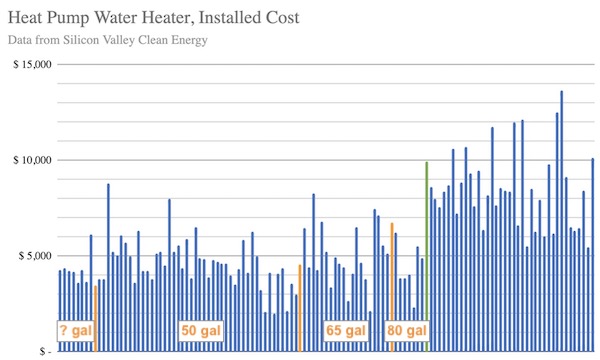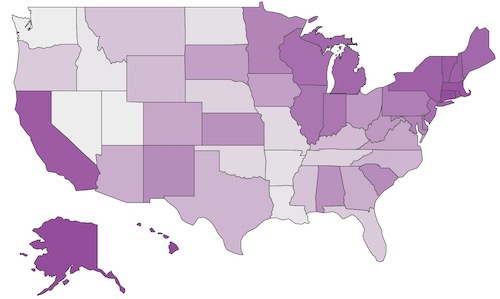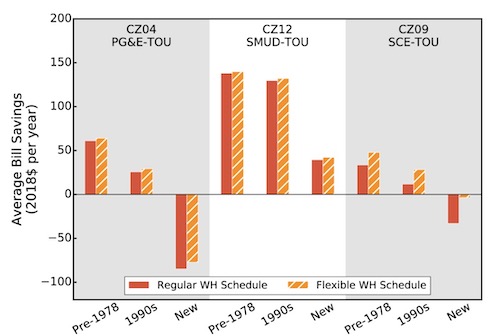This is the second post in a two-part series about heat pump waters heaters. The first post is here.
What does a heat pump water heat cost and will you break even? The answer is: It costs a lot and you may not break even, but you won’t lose your shirt either. If you want to reduce your home’s emissions, it will be the right choice for many of you. You can also increase the odds of breaking even with some effort. Read on for the deets.
What does a heat pump water heat cost?
Heat pump water heater installations have been running around $4500 installed, though prices are coming down. The median of the installations recorded with Silicon Valley Clean Energy in 2019 was $4877 and in 2020 was $4231. There is a lot of price variation, so it pays to shop around. For the purposes of this post, I will use a price of $4000, though with some effort you can get one installed today for $3500 or even less. (1)

Costs of 123 heat pump water heater installations over the last 18 months, as recorded by Silicon Valley Clean Energy. Installations to the right of the green line included an electrical panel upgrade. Older installations are shown to the left of each section.
The variation in prices does not seem to be related to tank size or type. If you arrange the installations by tank size, you will see there is little correlation.

Cost does not seem related to tank size
The majority of the cost is for installation. Retail prices of the water heaters are shown below, though contractors typically get a sizable discount.

Heat pump water heater costs filed with Silicon Valley Clean Energy over the period 2019-2020
You can see that a panel upgrade costs an additional $3500 or so. Since that upgrade can often be avoided, or it may be part of a larger project, this blog post will focus on installations without one. (2)
How does the cost compare with that of a gas tank water heater?
For the $4000 it costs to install a heat pump water heater, you could install three gas tank water heaters or two tankless. To encourage adoption until costs come down, local power providers are offering substantial financial incentives to replace gas water heaters with heat pump water heaters. Peninsula Clean Energy is partnering with the Bay Area Regional Energy Network (BayREN) on a $2500 rebate (you must use a BayREN-approved contractor). Silicon Valley Clean Energy is offering $2000. And the City of Palo Alto is offering $1200 (or $1500 if you have room for an 80-gallon tank). (3)
Will a buyer break even?
The rebates are big, but often not enough to cover the gap between the heat pump water heater (say $4000) and the gas-fired one (say $1200). You will still be running a deficit of about $300 if you use Peninsula Clean Energy, $800 if you use Silicon Valley Clean Energy, or $1500 if you live in Palo Alto. You might be wondering if the savings on your gas bill will make up for that. Unfortunately, the savings are not as big as you might hope. The heat pump uses only one-sixth the energy of the gas heater, but electricity is expensive, 4-5 times more than gas (per unit of energy). In a typical water heater retrofit, energy costs will go down by only $40/year or so. (4) Over the ten-year life of the water heater, you will break even with the Peninsula Clean Energy rebate, but otherwise, at today’s energy prices, you will be short $400-$1200. (5)
A comprehensive analysis from energy consulting firm E3 confirms this deficit. While many clean energy conversions are financially beneficial, even without rebates, heat pump water heater retrofits in our area generally are not.

Heat pump water heater retrofit costs, analyzed without rebates and using today’s energy prices, are not economical when compared with their gas (tank) counterpart. Tankless water heater replacements compare more favorably. Source: E3, 2019.
Should you get one anyway?
For many of you looking to reduce your emissions, the additional $400-$1200 expense of the heat pump water heater is worth it. Your home’s emissions go down by 30%, you remove unhealthy and dangerous gas from your garage or utility closet, you eliminate a source of smog (6), and it all works invisibly once the heater is installed.
You may also be anticipating that energy prices will evolve in a way that discourages adoption of gas appliances. The price on carbon may increase or, even without that, the gradual movement away from gas appliances will increase gas prices. By converting now you will stay ahead of the curve.
You might also consider the cost of the carbon dioxide you would be emitting by burning gas for your hot water. A gas tank water heater emits about 11 tonnes of carbon over its lifetime. To remove that amount of carbon and store it underground would cost around $12,000 today (using Climeworks). The heat pump water heater is a bargain! Or you might consider that many economists believe our emissions should be taxed at $50-$100/tonne, which lines up pretty well with the differential cost. Finally, you might take into account that green upgrades like this can increase the value of your home. This study in Nature Energy concluded that homes that have a heat pump for space heating enjoy a $10,000 or so premium in sales price by appealing to environmentally conscious buyers.
For all these reasons, many of you will decide that a heat pump water heater makes sense.
You can also make an effort to get one for $3500 or less. Some tips include:
- Shop around. Reach out to a number of installers. Check your local power provider, SwitchIsOn, and BayREN for possibilities, or the installation history from Silicon Valley Clean Energy.
- Facilitate the bids. Share with the candidates (a) a photo of your current tank, especially the top half so they can see the connections; (b) a photo of the larger area where it is installed, so they can determine how to drain the condensate; and (c) a photo of the inside of your electric panel, so they can assess capacity.
- Consider a 120-volt model. Rheem has two new (as of July 2022) 120-volt models available, which can significantly reduce electrical work (one requires just a standard outlet) and capacity in your electric panel. Because they rely exclusively on the heat pump, with no resistance element, they are for temperate climates only. Alternatively, the 15-amp 240-volt model requires less panel capacity than the 30-amp model while still allowing for fast refill in colder temperatures. Just be sure your installer knows your preference.
- Help out. Offer to buy your own heater and/or pull the permit on your own. That may save you some cost.
- Plan ahead. Consider getting any electrical work done in advance so the plumber can save time.
If not now, when?
When will heat pump water heaters reach cost parity without rebates? I am doubtful that will happen soon. The product and installation costs will have to come way down. One installer mentioned that permitting alone can contribute up to $1000 of the cost. In Palo Alto, a contractor might charge $150 to pull the permit, then the City charges $300 for the permit itself. The contractor might bill another $300-$500 to wait for and meet with the inspector. If our building departments streamline and discount this process, that will help. As installers gain experience (and competition) their time and labor costs for installation will continue to come down. Costs of the heaters should come down as well. But all of this takes a while, and once the installed cost has plummeted from $4000 to (say) $2200, the rebate will probably have gone away, leaving a $1000 gap. Energy prices have to change as well.
If electricity were free, the heat pump water heaters would be an easy win since you would save $200-$300 every year on energy bills. That’s not as far-fetched as it sounds. In Texas, there are many plans that offer free electricity at night. You could heat up your water at night for free, maybe to 130 instead of 120, then use it throughout the day, with a particularly hot shower in the morning. Nice!
Unfortunately, California has expensive electricity with relatively anemic time-of-use differentials. The map below shows how California’s electricity prices rank with the rest of the country.

California ranks 45 out of 50 in electricity prices, behind HI, AK, CT, RI, and MA. (Shade indicates rank.) Source: Choose Energy, 2021.
The E3 analysis mentioned above assessed whether scheduling the water heaters to run at low time-of-use rates would help. In practice it made little difference because the pricing differentials are small. (PG&E rates are shown in the left section, using a model based on the climate of Santa Clara County.)

Scheduling your water heater to avoid peak rates has little impact on bill savings. (This comparison is between a heat pump and a tankless gas water heater.) Source: E3, 2019.
It may be difficult for power providers to drop electricity rates much, given the work needed in California to harden the grid from fires and build in resiliency. Christine Tam, a Senior Resource Planner for the City of Palo Alto Utilities, mentioned that transmission costs went up 15% in just the last year alone. If electricity rates do drop a modest amount, we will still need the price of gas to go up to make the heat pump water heater the cheaper option. For example, if electricity prices drop by 15% and gas prices go up by 15%, then the customer saves at least $100 each year with the heat pump water heater and the switch makes sense. An easier approach may be for California power providers to develop more aggressive time-of-use rates ala Texas.
Some types of electrification retrofits are clear financial wins in the Bay Area, like space heating combined with air conditioning. It’s tougher to make the case for heat on its own, whether space heating or water heating. Our climate is mild and getting milder, so we don’t use enough heat to justify efficient but costly appliances. Policy and pricing need to come together to wean us off of fossil fuels. The rebates are a big help, and the Building Decarbonization Coalition has other great ideas.
I find it particularly hard to reconcile California’s clear desire to electrify its buildings with the fact that our power providers charge some of the highest electricity rates in the country. Stay tuned next week to learn more about why California’s rates are so high and what might be done about it.
In the meantime, those of you interested in reducing your home emissions by almost one-third can take advantage of aggressive rebates today and a growing list of certified installers to get a right-priced installation with a little bit of planning. This is a one-and-done deal, taking no effort once the change is made. Imagine how nice it would be to take a hot shower without heating the planet at the same time!

Update
Check out my post from September 2021 on price gouging in the HPWH market and how to combat it.
Notes and References
0. I want to thank Menlo Park Environmental Quality Commissioners Josie Gaillard and Tom Kabat for their contributions to this blog post. Gaillard and Kabat spend a good deal of time working to understand and improve the economics of electrification, and I particularly appreciated their perspectives on this post and the many tips they shared for lowering costs.
1. Silicon Valley Clean Energy collects information about installers. From their records, Air & Plumbing Systems in Los Gatos, which does its own electrical work, has prices right around the median and has done many installs. The other big installer, EJ Plumbing, has higher prices (median $5208), possibly because it does not do the electrical work in-house. I am told that there are plumbers who, if you order the tank and file for the permit yourself, will do the work for around $2000, for a total expense of around $3500.
2. In Silicon Valley Clean Energy’s data set, 39 out of the 123 installations, or 32%, did a panel upgrade. Many could likely have done without. It is important to remember to get a 15-amp model rather than 30-amp. If needed, consider sharing a 240v circuit with a splitter like this.
3. These rebates only apply when you are replacing a gas fired water heater. There are rebates to replace an electric resistance water heater, but they are much smaller. Both Peninsula Clean Energy and Silicon Valley Clean Energy are also offering partial rebates for panel upgrades if they are needed.
4. Here is the math for that, in case you want to plug in your own numbers. Let’s say your annual gas use is 600 therms, which is about average for our area. Maybe 30% of that, or 180 therms, is used to heat water. In Palo Alto that might cost $216 (at $1.20/therm, assuming costs are split across the two tiers), while with PG&E that might cost $306 (at $1.70/therm, again assuming costs are split).
What will it cost with a heat pump water heater? Electricity is more expensive (a $0.25/kWh rate is equivalent to a $8.80/therm price). But electric heat pumps are much more efficient. A gas water heater that burns 180 therms of gas will waste about 40% of that energy, effectively heating the water with only 108 therms. On the other hand, an electric heat pump that needs to generate 108 therms of energy to heat water will consume only 30 therms (880 kWh) from the wall, getting the rest of the heat from the surrounding air. (This assumes a modern heat pump with UEF 3.55.)
In Palo Alto those 880 kWh might cost about $167 (at $0.19/kWh in Tier 2), while with PCE and SVCE that 880 kWh might cost about $264 (at $0.30/kWh in Tier 2). In either case, the savings is only about $40/year.
You can plug in your own rates to see how much cheaper your electric cost will be. Take your electricity rate (in kWh) divided by your gas rate (in therms), and multiply by 4.95. For example, if your electricity rate is $0.22/kWh and your gas rate is $1.30/therm, then the result is 4.95 * $0.22 / $1.30 = 0.84 or 84%. You will save 16% on the amount you pay today for hot water. (If your use is well into the second tier of pricing, then use that price, otherwise use the first tier or a mix.)
You may also want to keep in mind that gas prices are likely to go up over the coming decade, likely increasing the savings on your energy bills if you switch to electric.
5. Those of you with your own solar power, with large hot water demands, or with a particularly well maintained and long-lasting tank will fare somewhat better.
6. Panama Bartholomy of the Building Decarbonization Coalition estimates that buildings in California produce more smog than cars, and about seven times more smog than power plants.
Current Climate Data (December 2020)
Global impacts, US impacts, CO2 metric, Climate dashboard (updated annually)
Comment Guidelines
I hope that your contributions will be an important part of this blog. To keep the discussion productive, please adhere to these guidelines or your comment may be moderated:
- Avoid disrespectful, disparaging, snide, angry, or ad hominem comments.
- Stay fact-based and refer to reputable sources.
- Stay on topic.
- In general, maintain this as a welcoming space for all readers.



